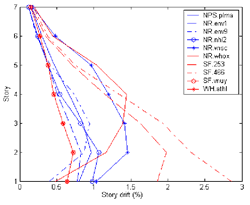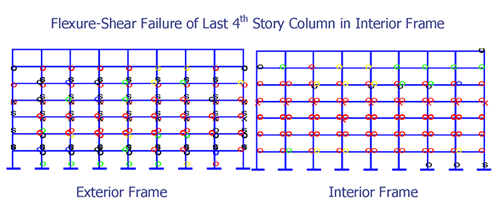| Project Title/ID Number |
Development of EDP-DM-DV
Relationships for RC Building Components—3422003 |
| Start/End Dates |
10/1/03—9/30/04 |
| Project Leader |
Laura Lowes (U Wash/F) |
| Team Members |
Nilanjan Mitra (U Wash/GS) |
F=faculty; GS=graduate student; US=undergraduate student; PD=post-doc; I=industrial
collaborator; O=other
Click on images to enlarge in a new window
1. Project Goals/Objectives:
The proposed research will develop EDP-DM-DV models for reinforced concrete
beam-column joints. One set of models will enable the use of engineering
demand parameters (EDPs), which are the traditional output of structural
analysis, to predict component-specific damage measures (DMs). A second
set of models will link component damage measures to repair techniques
and provide a method for computing total repair effort. Total repair effort
is considered a decision variable (DV) that is meaningful to building owners.
2.
Role of this project in supporting PEER’s mission
(vision):
The results of this project will enable researchers and consultants
to evaluate the economic impact of earthquake loading of a structure,
using damage scenarios that include component-specific damage predictions.
3. Methodology Employed:
A year 4 project resulted in the development of probabilistic models
linking joint deformation as observed in the laboratory with repair-specific
damage states and then developing a method for predicting repair cost
and time given joint damage. A year 2-3 project resulted in the development,
and implementation within the OpenSees environment, of a model that can
be used to predict the earthquake response of beam-column joints. This
year-7 project extends the previous work in three critical ways:
-
Analyses
will be conducted using OpenSees and the previously developed beam-column
models to simulate the response of the test assembles used
to generate the probabilistic damage model. The results of these
analyses will be used to quantify model inaccuracy. Then, the probabilistic
model linking observed deformation with damage will be extended to
provide
a link between predicted deformation and the previously identified
repair-specific
damage states. In this way, modeling uncertainty will be included
in damage prediction.
-
The results of the year-4 project included a proposed
method for
predicting repair cost / time using information about component
damage. This issue
will be investigated further to improve the accuracy with which
repair costs are predicted and explore different approaches to
predicting economic impact. PEER BIPs will be used as a resource for
this
phase
of the project;
other PEER researchers will be consulted as well.
A year-5/6
project focused on simulation of the response of the Van Nuys Holiday
Inn building using the component models
available within
OpenSees.
This included explicit simulation of the inelastic response
of beam-column joints using numerical models developed
by the PI (year 2-3 project)
as well as others (e.g., Deierlein). The results of phase
1 and 2 of the project will be demonstrated through prediction
of the economic
impact of damage resulting from earthquake loading of the
Van Nuys Holiday Inn.
4. Brief Description of past year’s accomplishments
(Year 6) & more detail on expected Year 7 accomplishments:
A year-6
project focused on simulation of the response of the Van Nuys Holiday Inn
building using the simulation tools available within OpenSees. The results
of this project include the following:
-
Quantification of the impact of modeling
uncertainty on prediction of engineering demand parameters for the
Van Nuys Holiday Inn. Examples of
numerical data generated as part of this study are provided in
Figures
1a and 1b, which show the impact of modeling decisions on the predicted
inter-story drift of the Van Nuys building for the “50in50” and “2in50” earthquake
hazard levels. These data can be compared with the data in
Figures
2a and 2b that show the impact of ground motion variability on predicted
inter-story
drift.
(Click on image to enlarge)
Figure 1a: 50in50 eq. hazard level
Figure
1b: 2in50 eq. hazard level

 Figure 2a:
Figure 2a: 50in50 eq. hazard level
Figure
2b: 2in50 eq. hazard level
Evaluation of exiting models for predicting the response of older
reinforced concrete buildings. An example of the numerical data generated
as part of the study is provided in Figure 3, which shows predicted curvature
ductility demands for beams and columns as well as the locations of column
flexure-shear and splice failures in the Van Nuys Holiday Inn building
under static lateral loading.
 Figure 3:
Figure 3: Distribution of Damage and Yielding at Failure under Static Lateral
Loading
Year 7 accomplishments will extend the results of the year-4 project and
provide models for use in predicting beam-column joint damage. Expected
outcomes include models linking predicted deformation with component damage.
Such models will be similar in nature to that shown in Figure 4 that links
observed inter-story drift to joint damage.

Figure 4: Probability of an Older Joint Exceeding a Repair-Specific
Damage State as a Function of Maximum Inter-Story Drift and Number of Load
Cycles
5. Other Similar Work Being Conducted Within and Outside
PEER and How This Project Differs:
I am unaware of similar work being done be researchers outside
of PEER. Similar work is being done by researchers within PEER and includes
the following:
-
Modeling of beam-column joint response and correlation
with damage: Lehman and Stanton at UW are developing simplified joint
models for use
with OpenSees and correlating predicted joint deformation with damage
observed in the laboratory.
-
Prediction of component damage: Miranda
has developed probabilistic models linking structural deformation,
as well as other engineering
demand parameters that can be predicted using typical nonlinear
analysis software,
to component damage and loss.
The work proposed here differs from
the Lehman/Stanton project in that 1) the numerical model used
to predict joint response
and the probabilistic
models use to link joint deformation to observed damage are
appropriate for use for a broad range of joint designs and 2) the work
being
done here focuses on linking damage with repair to developing
models for predicting
repair cost / time. The work proposed here complements the
Miranda project in that Miranda has not, thus far, addressed damage
and
loss prediction
for beam-column joints.
6. Plans for Year 8 if project is expected to be continued:
The project is not expected to continue in Year 8.
7. Describe any actual instances where you are aware your
results have been used in industry:
None known.
8. Expected Milestones & Deliverables:
The proposed research objectives translate into a series of research tasks.
These tasks will be accomplished by the PI, one new graduate student researcher
and one continuing graduate student researcher during a one-year period.
Completion of each task is considered a milestone; deliverables are identified.
Task I: Working with an existing set of experimental
data and OpenSees component models to develop models that link predicted
EDPs with observed
DMs, and
thereby include modeling uncertainty. Deliverable: EDP – DM
models.
Task II: Work with PEER BIPs and other PEER researchers to answer
the following question:
How best can repair effort be modeled so that analysis results can be tied
to total building repair effort? Deliverable: Method for
predicting repair effort given prediction of building damage.
Task III: Interview structural engineers,
contractors and consultants and review cost estimating resources to develop
a model for computing the cost
and time required to repair beam-column joint damage.
Task IV: Propose a
method for computing total repair effort on the basis of component damage,
as characterized by component-specific damage measures.
Deliverable: EDP – DM - DV model.
